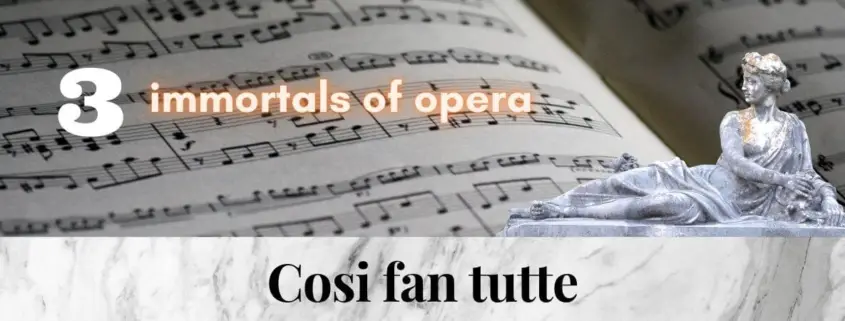The opera is based on the devilish libretto by Lorenzo da Ponte. On the surface it is a comedy about a vile game. And Mozart poured out his most tender melodies about it. When Mozart wrote “Cosi fan tutte” in 1790, he was economically down. He wrote this opera in an incredible 2 months in the penultimate year of his life. Mozart again offers us a wealth of melodies. Especially the ensemble scenes like the love duets “Soave sia il vento” or “Il mio cor vi dono” remain immortal.
The great farewell scene – “Soave sia il vento”
This trio is one of Mozart’s absolute greatest vocal pieces, he transports us to a supernatural world. Mozart accompanies the three voices with muted violins imitating gentle waves. In addition, the quiet pizzicati of the low strings and a long curved line of the viola bill, which draws the tranquility of the landscape.
You will hear this tercet of an interpretation by Christa Ludwig and Elisabeth Schwarzkopf, two great artists, and Walter Berry. This recording comes from the legendary Cosi fan tutte recording produced by Walter Legge.
Soave sia il vento – Schwarzkopf / Ludwig / Berry.
Come scoglio – Fiordiligi’s “Rock Aria”
This piece of Fiordiligi is one of Mozart’s most difficult arias ever. The tonal range of the aria is large, almost two octaves, and often several leaps fall into the same phrase. For example, in the first part, right at the beginning in the second line in “Contro venti e tempesta” to underline the dramatic nature of Fiordiligi’s statement “like a rock unshakable” (“Come scoglio”). In the second part (“Cosi ognor”) we hear the romantic, rapturous Fiordiligi. In the third part she sings with greater determination the “Come scoglio” passage (death alone is able to turn the sentiment). The aria ends with a beautiful but demanding passage with many coloraturas, which must be sung at a fast tempo and with much intensity and sometimes in a very high register.
Fiordiligi was one of the five central roles Elisabeth Schwarzkopf played in her life (along with the Marschallin, Donna Elvira and the two Countesses in “Le nozze di Figaro” and “Capriccio”). Her singing style and voice were perfectly suited to these roles. Perhaps there was no greater Fiordiligi than Elisabeth Schwarzkopf.
Come scoglio – Schwarzkopf.
The Romantic Aria of the Albanian in Disguise – “Un aura amorosa”
This aria is a lyrical rest. Accompanied by muted violins and warm bass sounds, Ferrando sings a romantic aria.
Ferrando’s aria “Un’aura amorosa” belongs to the exclusive circle of highlights of the opera. Listen to the aria interpreted by Léopold Simoneau from the Karajan recording. Kesting said, “The Karajan recording is one of the great Mozart recordings of the century. It is more than technically perfect, namely miraculous in its liveliness and subtlety. Simoneau sings his part with indescribable tonal sweetness.”
Un aura amorosa – Simoneau







Leave a Reply
Want to join the discussion?Feel free to contribute!